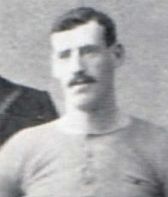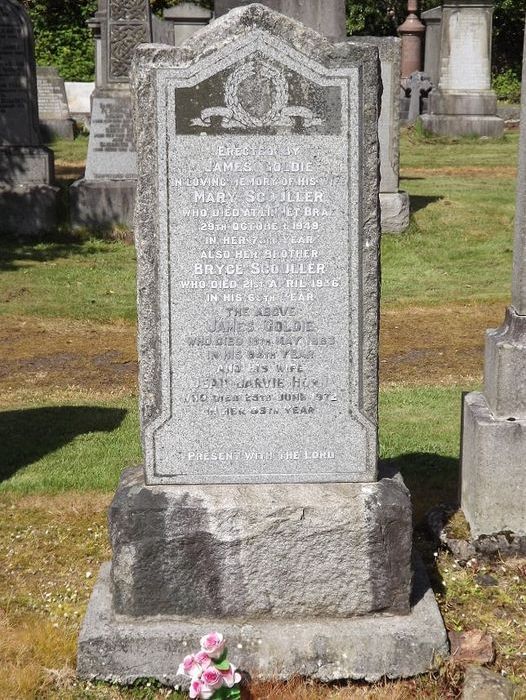Thomas "Tommy" Hyslop
aka Bryce Scoul(l)er

Tommy Hyslop, or as he was born, Bryce Scoular or Scoullar , seems until the last decade and a half of his life to have been a man in a hurry, in fact too much of a hurry. Although born in Auchenleck in Ayrshire he was raised mainly in Renfrewshire, in Johnstone, playing his earliest football in neighbouring Elderslie. But he seems to have made no great sporting impression. Although noted later as having not the best technique and an awkwardness but at 6ft 3ins a considerable physique, speed and a fierce, accurate shot, he must have been a late-developer. When at sixteen cum seventeen he joined the Royal Navy for two years as a message-boy he had been recorded as just 5ft 5ins tall.
And he clearly took a liking to military life for he is said then to have enlisted in the Argyll and Sutherland Highlanders, after a year to have gone AWOL, only to re-emerge in 1890 in the Scots Guards but under the assumed name of Thomas Hyslop, a combination of his second name and his mother's maiden-name. And there, posted to Windsor, he began to play regimental football. As centre-forward for 2nd Battalion he would help to win the Army and the Middlesex Cups, both twice. He also represented the Army against Corinthians and featured for Middlesex, the county. He was, meantime, attracting attention from professional clubs, whilst the Army wished to retain him as a two-fold sharp-shooter. As a result after playing an unauthorised trial game for Millwall Athletic he was disciplined and when in 1893 Sunderland came in with an offer the club was obliged in addition to buy him out of the service.
In fact his time at Sunderland was not a particular success. He struggled to get into the first eleven and in 1895, as The Makems won the title, he was allowed to go to mid-table Stoke and to some effect. The following season The Potters finished one rung below the now fifth-placed Wearsiders and it was enough for him both to be called up for a first cap, and against England, and return North, signed by Rangers.
The two seasons he was to spend at Ibrox in contrast to Roker Park would come with considerable success. The Scottish-, Glasgow- and Charity Cups were all won in the first campaign, the Scottish Cup again in the second. He was twenty-seven and should have been at his peak but a return to Stoke for a year was unsuccessful as was the following year back with The Gers and he was released. However, he went to newly-promoted Partick Thistle and was top-scorer, albeit with the team immediately relegated but at least with him by then already called up to serve in the Boer War.
He was by now almost thirty, thirty-one when demobilised, then played a few games in Dundee but essentially returned to Renfrewshire to work there and play locally, now a full-back with Johnstone and Abercorn. He also went on the stage as a strong-man before he made the last great leap in his footballing adventure. In March 1906 he emigrated to the United States to work eventually as a carpet-weaver but also play a integral part in the rebirth of US soccer after economic depression.
And on arrival he went straight to Kearny, US Soccertoon, in New Jersey. At the end of April 1906 he had joined the Scot-American team that reached the semi-final of that year's American Cup. And he was in the same team in May that lost that last four encounter on a replay, scoring in both legs. Then he found his way to Philadelphia, where he would settle, there joined the Thistle club and in 1910, aged thirty-eight, was in the equally local but semi-professional Tacony team that would then win that same American Cup.
It is said that Tommy Hyslop continued to play into his forties. But it must have come to an end when first in 1917 he lied not entirely about his name this time but about his age once more and previous military experience in joining the Canadian army, was posted to France as a part of its Expeditionary Force and in 1922 took the decision to return home, and back to Paisley.

And in joining the Canadians he had also lied about one more thing. He said he was single. In fact he was married and had been as far back as 1898, in Stoke-on-Trent to a Northumbrian lass, Jane Angus. And in 1900 a daughter was born back in Alnwick and would grow up there. Jane would die in Northumberland in 1944. Tommy would predecease her by eight years, passing away in 1936 in Paisley's Royal Alexandra Infirmary, this whilst living with a brother in Elderslie. He was sixty-four and is buried with his sister and her family in Johnstone's Abbey Cemetery.
Birth Locator:
1871 -- Main St., Auchenleck, Ayrshire
Residence Locations:
1881 - Public Road, Johnstone, Renfrewshire
1891 - N/A
1901 - Windsor, Berkshire
1910 - 2549, Mascher St., Philadelphia
1917 - 2532, N. Mascher St., Philadelphia
1921 - USA
1936 - Linnet Brae, Elderslie, Renfrewshire
Death Locator:
1936 - Royal Alexandra Infirmary, Paisley
Grave Locator:
Abbey Cemetery, Elderslie, Renfrewshire
Back to Johnstone & Paisley,
the Cart Trails
or the SFHG Home page